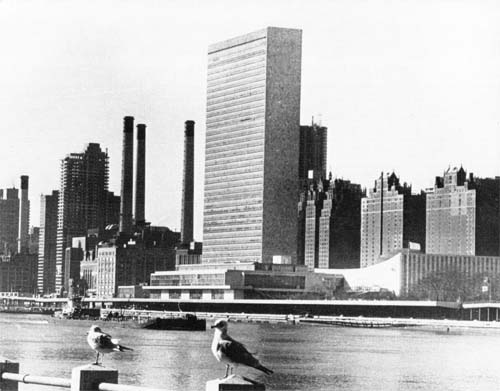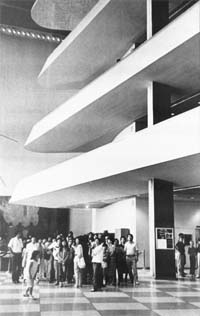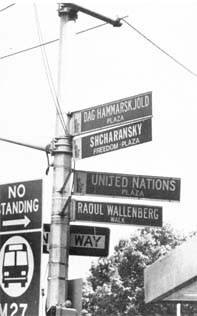 |
| The United Nations with Tudor City in the background, viewed from across the East River. |
 |  | |
| Left: Lobby of the General Assembly Building, United Nations. Right: Street sign near the United Nations. | ||
| Home | Tours/Lectures | Books | Maps | Posters | Pictures | Contact |
UNITED NATIONS
United Nations Plaza and 42nd Street
The United Nations is between First Avenue and the East River from 42nd to 46th Streets. In contrast to The Rockefeller University, everyone knows where the UN is, it being the most visited spot in the city, surpassing the Statue of Liberty.
Strange as it may seem, this was the setting of slaughterhouses and breweries. Geographically it is part of Turtle Bay, there being once a small bay at the shore. Into it flowed the creek which began in Central Park and left the park around Fifth Avenue and 59th Street. (It was by damming this creek that Olmsted and Vaux created the Pond.) North of here, on the shore, was the country place of the Beekman family which is supposed to have had the first greenhouse built in this country. In 1846 Edgar Allan Poe lived in a house at the foot of 46th Street, before moving to what is now called Poe Cottage on Grand Concourse and Kingsbridge Road in the Bronx. Even in his day there was some industry, a fat-reduction works on the nearby shore. By the 1850s there was a pencil and penholder factory at 42nd and 43rd Street, and slaughter houses with hide-and-fatworks up to 46th. A squatters' colony made up of German and Irish immigrants occupied the bluff where Tudor City stands. By the 1900s a gasworks had replaced the pencil and penholder factory, while slaughterhouses occupied the rest of the area, with a railroad slip for carfloats and some tracks at the shore north of 46th.
By the time of World War II, industry, including the slaughter houses, had vacated the area. In 1946 William Zeckendorf, a leading real estate developer of the postwar decade, who was handling the American Astor Estate, obtained 85 percent of the land from 41st to 48th Street east of First Avenue. He wanted to build a $100,000,000 complex of mixed office and apartment buildings to be designed by Wallace K. Harrison, one of the architects who had worked on Rockefeller Center.
That same year the UN was desperately seeking a permanent site for its headquarters, after the United States had been selected as the country to be honored. Nelson Rockefeller was a member of a team put together by Mayor William O'Dwyer to secure a permanent home for the UN in New York City. At one point, John D. Rockefeller, Jr., and his five sons agreed to donate part of the family's estate in Westchester County, New York as the UN site, but the UN preferred a location closer to the city. Wallace K. Harrison suggested the site on the East River owned by William Zeckendorf. After a hurried series of conferences to beat the UN's deadline, Mr. Rockefeller, Jr., agreed to donate $8.5 million to the UN to purchase the East River site from Zeckendorf.
The next year the Secretary-General Trygve Lie named a board of designers with Wallace K. Harrison as chairman. His firm, Harrison & Abramowitz, had charge of the designing; a future head of the Municipal Art Society, Harmon Goldstone of the firm's staff, was in charge of the planning.
At the UN, on the waterside, east of the General Assembly Building, is the splendid rose garden with an espalier of pear trees set against a long wall.
The tour goes north on First Avenue to 51st Street, then west. It stops at Greenacre Park, .14 acres, on the north side of the street between Second and Third Avenues.
 |
| The United Nations with Tudor City in the background, viewed from across the East River. |
 |  | |
| Left: Lobby of the General Assembly Building, United Nations. Right: Street sign near the United Nations. | ||